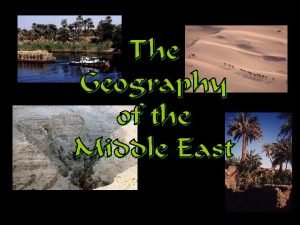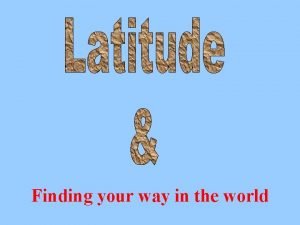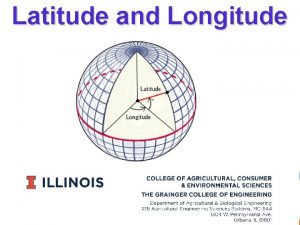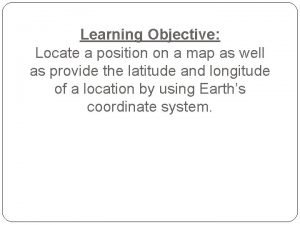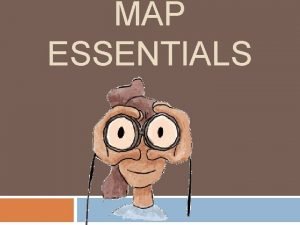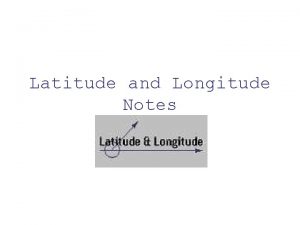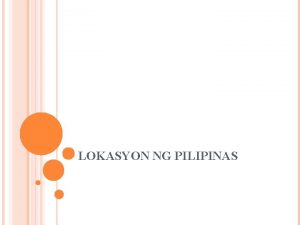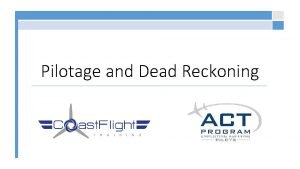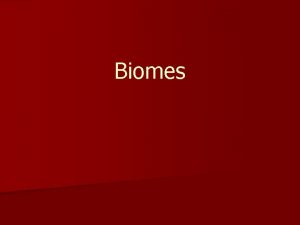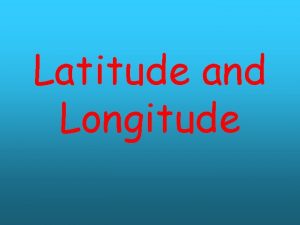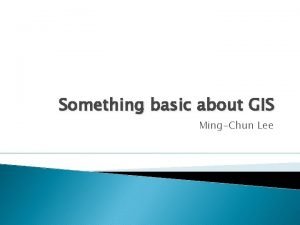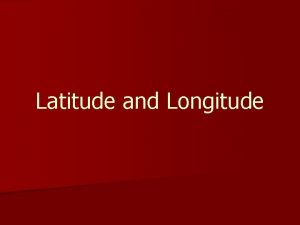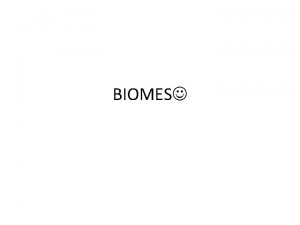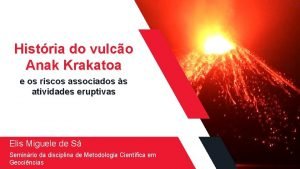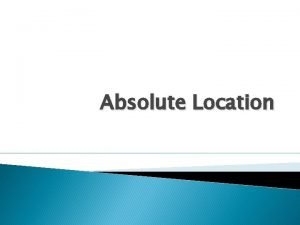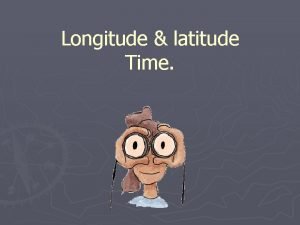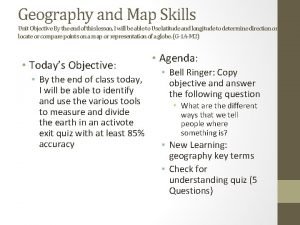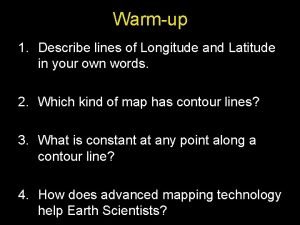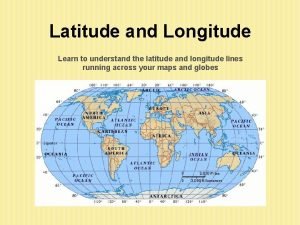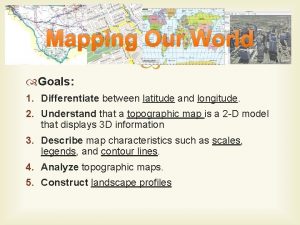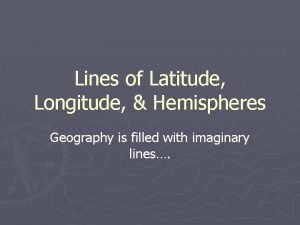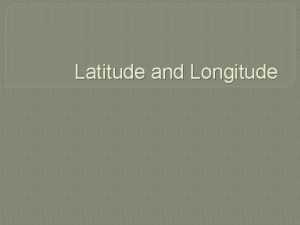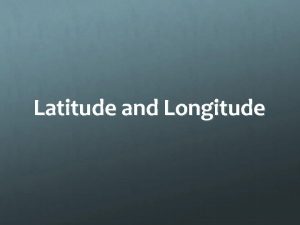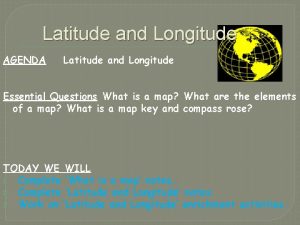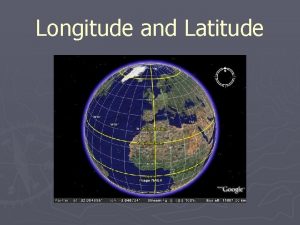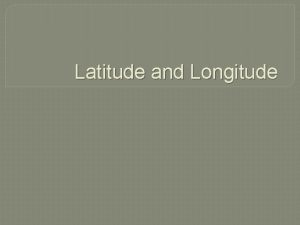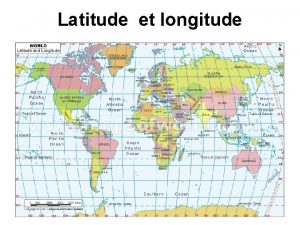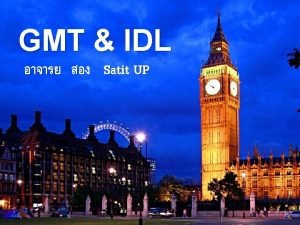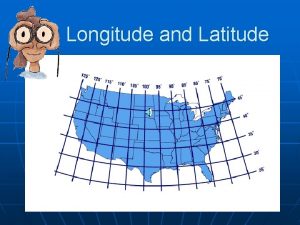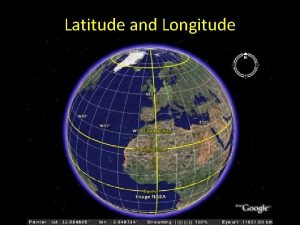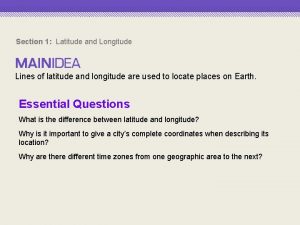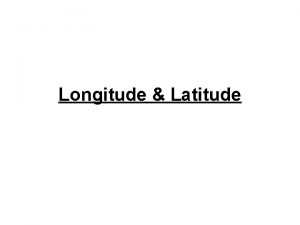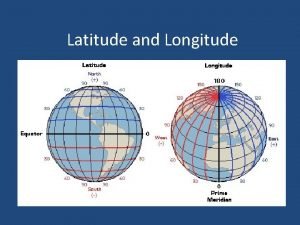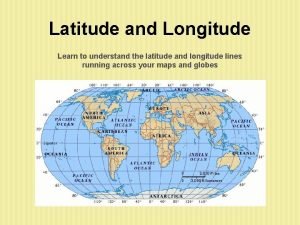Latitude Longitude 13 00 122 00 E Lipa



























- Slides: 27


Latitude / Longitude 13 00 122 00 E Lipa City , Philippines GPS Coordinates: 121. 16442, 13. 94188

Creating Environmental Awareness and Sensitivity Through Service Learning in Ecology Class Bernardo Cuevas Lunar Biology Department and Science Area College of Education, Arts and Sciences colonelc 4 b@yahoo. com Associate Professor& Research Faculty Office of Research and Publication De La Salle Lipa

Background One Million Trees and Beyond (OMTB) Project and the Project Carbon Neutral (PCN) of De La Salle Philippines service- learning modules to integrate such projects with the Ecology class stepwise activities that were carried out in service-learning modules as they intend to create environmental awareness and sensitivity among students.

Objectives looked into the different phases of the service - learning design employed in Ecology Course of De La Salle Lipa • Specifically, it aimed to assess the activities during the development and design phase; implementation phase; reflection and assessment phase; and evaluation phase. •

Operational Framework INPUT PROCESS Development and Designing of Service Learning Modules Implementation, Reflection, Assessment, and Evaluation OUTPUT + Environmental Awareness + Environmental Sensitivity Responsible Behaviour Participative Action

Methods Locale and Respondents * De La Salle Lipa * 35 BS Biology and BS Education students Design • Descriptive design employing focused conversation as data gathering technique • data were validated by interviews and observations all throughout the course of the study 7

Findings On Development and Designing * Transformative Learning employed in the Ecology classes * Service-learning was integrated with the usual lectures to reflect an outcomes-based learning experience • Banking on the Expected Lasallian Graduate Attributes (ELGAs): critical thinkers, excellent communicators and socially responsible citizens

Findings On Development and Designing * In order to come up with the right choice of intervention areas, strategy and community service partners, a basic situation analysis was conducted. • Since the school is actively participating in the environmental projects spearheaded by De La Salle Philippines’ Lasallian Institute for the Environment (LIFE) • to stay relevant and to address real needs of the key stakeholders, collaborative partnerships were designed with the offices, service agencies and the community that were actively involved in the OMTB and PCN projects of the school. 9

Findings On Development and Designing Taking into consideration the teaching and learning outcomes and the potential expectations of the students: • the service- learning approach explored was problem-based service learning for the Service Learning Module I: Schoolyard Ecology * deployed the students to a botanical inventory of the mature trees planted inside the school premises. • and, capstone modules for Service Learning Module II: Community Ecology * actual facilitating of an environmental recollection among high school students in a partner school 10

Findings On Development and Designing Service-learning outcomes of the service-learning modules focused on : academic learning and enhancement, personal growth; and social responsibility 11

Table 1. B Students’ Over-all Preferred Practical Examination Type Findings On Implementation • The second phase of integrating service-learning in a module is actualizing the program. • Even though the modules have been predesigned and developed, certain modifications were made to tailor-fit them to the actual situation. • It entailed incorporating meaningful and fun- filled service activities as students tend to be bored with the monotony of the activity especially when they were doing vegetation inventory

Table 1. B Students’ Over-all Preferred Practical Examination Type Findings On Implementation • Since it required bringing the students out of the classroom and even out of the school, logistics and budget were carefully planned. • Pull-out forms, waiver, permits and pertinent documents were secured, considering the possible risks and liability issues immanent in the module. • Project orientations on OMTB and PCN were conducted and students were made to complete the trainings on community ecology and recollection facilitation before they were deployed.

Table 1. B Students’ Over-all Preferred Practical Examination Type Findings On Implementation • For the first module on Schoolyard Ecology, students were asked to perform services for three hours per week for six weeks during their Ecology Laboratory Classes. • The period given was long enough for them to finish the inventory and accomplish the tally sheet required by the problem-based learning approach. • For the second Module on Community Ecology, students were given 24 working hours to prepare and actualize their assigned capsule modules.

Table 1. B Students’ Over-all Preferred Practical Examination Type Findings On Implementation • It was ensured that a portion of lecture time was allocated discussion what the students were seeing, feeling, and thinking about the experience. • Although attendance of students was religiously checked, they were not evaluated for merely accumulating hours performing the service. • Reflection activities and tangible outputs like updates on the number of trees measured and identified and photo essays were required for submission by the students as basis of how well they participate and learn in the process

Findings On Reflection and Assessment • Focused conversation and reflection using the ORID Method were used in making the student participants assess the entire course of service learning. • This method looked into the : • Objective mode • Reflective mode • Interpretative mode • Decisional mode

Findings On Reflection and Assessment • Objective Mode • a student said “PCN is a program of all Lasallian Institutions that aims to assess the actual carbon footprint in each school geared at attaining carbon neutrality by balancing the emission by mitigation and sequestration measures. We made and inventory of the vegetation of the school, focusing on trees. From the statistics we gathered, were able to compute for the carbon stock. This information is deemed important baseline data for the PCN Sequestration committee”. 17

Findings On Reflection and Assessment • Reflective Mode • another student said “Fortunately, we were housed in a wonderful and nature-endowed site where various and numerous species of plants and animals reside. It was a great time sharing to them the importance of preserving our environment and natural resources. One by one and step by step, we were able learn, just as how the people and the community were able to learn”. 18

Findings On Reflection and Assessment • Interpretative Mode • a Biology student put it this way: “The best things that I realized and cherish from the service learning are these: having been able to keep my role as steward and having been able to share my knowledge and inspire others to partake in the mission of saving our Mother Earth”. • “I will continue what I have started because I believe this is the perfect time for me to bring in change. I will be a good student and a good citizen, and I will be a good role model to my siblings. If I will be given the chance to be part of the service learning group, I want to be part of the coral conservation team”. 19

Findings On Reflection and Assessment • Decisional Mode • an Education student put it this way: ““This project made me realize that technology is good enough to make our lives easy, but it also has its negative impacts on our environment. We enjoy so much the use of technology without knowing how huge amount of carbon dioxide it releases. From now on, I would like to lessen my use of certain gadgets and stuffs that contribute a lot to carbon emission. I would rather conserve energy and water in order to help protect the environment”. 20

Findings On Evaluation Evaluating its impact to the students is likewise manifested that the service- learning in Ecology satisfied the four criteria of a good service- learning experience by Howard (2001) and Stacey, Rice and Langer, (2001): • relevant and meaningful service with the community; • enhanced academic learning; • purposeful civic learning or social responsibility; and • structured opportunities for reflection 21

Some photos… 22

Some photos

Conclusion 1 2 ed that concept s of ecology and environ • Service- mental learning educatio could be n can be considered a very good well tool in imparte creating d environment through al awareness the use and of sensitivity various thereby teaching effecting strategi responsible es. behaviours

Recommendation A replication of this study perhaps, i e need to enhance the implementation of another Science subjects and a conduc A more thorough assessment of the said ervice learning classes by targeting other comparative study of service learnin program, involving both the giver and the problems and communities, employing between and among different subjec recipient of service should be done different approaches and strategies may also be taken into consideration future teaching and learning endeavou

References Ammon, M. S. , Furco, A. , Chi, B. , & Middaugh, E. (2002). A profile of California's Cal. Serve service-learning partnerships: 1997 -2000. Sacramento, CA: California Department of Education. Bringle, R. G. , Phillips, M. A. , and Hudson, M. (2004). The Measure of Service Learning: Research Scales to Assess Student Experiences. American Psychological Association, Washington, DC. Cunninghamm, G. Transformative Learning: An Epistemological Study of Kalamazoo College Student Learning Outcome 2009. 3 rd National Cofenrence on Innovations in the Scholarship of Teaching and Learning at the Liberal Arts Colleges, Wabash College, Crawfordsville, Indiana, March 6 - 8, 2009. Eyler, J. S. , Giles, D. E. , Stenson, C. M. , and Gray, C. J. (2001). At a Glance: What we know about the effects of service-learning on college students, faculty, institutions and communities, 1993 -2000: Third Edition. Funded by the Corporation for National Service Learn and Serve America National Service Learning Clearinghouse. Furco, A. 2002. “Is service-learning really better than community service? ” in Furco, Andrew and Shelley Hl. Billig, eds. Service-Learning: The Essence of the Pedagogy. Greenwich, CT: Information Age Publishing Inc. 2002, p. 25. Gearan, Mark D. (2005). Engaging communities: The Campus Compact model. National Civic Review, 32 -40. Kirkham, M. (2001). Sustaining service-learning in Wisconsin: What principals, teachers, and students say about service-learning, 2000– 2001. Madison, WI: Wisconsin Department of Public Instruction. Klute, M. M. (2002, December). Antioch's Community-Based School Environmental Education (CO-SEED): Quantitative evaluation report. Denver, CO: RMC Research Corporation. Klute, M. M. , & Billig, S. H. (2002). The impact of service-learning on MEAP: A large-scale study of Michigan Learn and Serve grantees. Denver, CO: RMC Research. Klute, M. M. , Sandel, K. , & Billig, S. H. (2002). Colorado Learn and Serve evaluation. Denver, CO: RMC Research Corporation. Mc. Namara, C. (2011). Basics of action planning. Retrieved March 31, 2011 from: http: //managementhelp. org/plan_dec/str_plan/actions. Rabago, L. 2000. Southeast Asia Report. Available in http: //environscope. iges. or. jp. pdf. Shumer, R. , Duttweiler, P. , Furco, A. , Hengel, M. , and Willems, G. (2000). Shumer’s Self-Assessment for Service-Learning. Tannen, D. (1998). The Argument Culture. Random House, New York Thapa, B. , 1999. “Environmentalism: The Relation of Environmental Attitudes and Environmentally Responsible Behaviors among Undergraduate Students”, Bulletin of Science Technology Society 19: 5 Welch, M. and Billig, S. H. (eds. ) (2004). New Perspectives in Service-Learning: Research to Advance the Field. Information Age Publishing, Greenwich, CT.

 Middle east natural resources
Middle east natural resources Longitude latitude
Longitude latitude Lines that run from north to south but measure is and west
Lines that run from north to south but measure is and west 40 degrees north latitude
40 degrees north latitude Lines of latitude run from
Lines of latitude run from Who invented latitude and longitude grid system
Who invented latitude and longitude grid system United states latitude map
United states latitude map Philippine map with latitude and longitude
Philippine map with latitude and longitude Map of the world with longitude and latitude lines
Map of the world with longitude and latitude lines Latitude and longitude notes
Latitude and longitude notes Paraan ng pagtukoy ng lokasyon
Paraan ng pagtukoy ng lokasyon Latitude and longitude aviation
Latitude and longitude aviation Longitude
Longitude Limnetic zone
Limnetic zone How to read latitude and longitude
How to read latitude and longitude How many degrees in latitude
How many degrees in latitude Longitude and latitude
Longitude and latitude Prime meridian map
Prime meridian map Temperate grassland latitude and longitude
Temperate grassland latitude and longitude Krakatoa latitude and longitude
Krakatoa latitude and longitude Lines of latitude run from
Lines of latitude run from Latitude shape
Latitude shape Geographic coordinate system examples
Geographic coordinate system examples Describe the lines of latitude.
Describe the lines of latitude. How to learn longitude and latitude
How to learn longitude and latitude Differentiate between longitude and latitude
Differentiate between longitude and latitude Northern hemisphere latitude
Northern hemisphere latitude Understanding latitude and longitude
Understanding latitude and longitude
